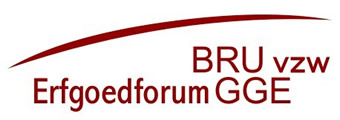Het ontwerp van het UNESCO rapport
World Heritage
Patrimonies mondial
34 COM
Distribution limited / limitée
Paris, 1 June / 1er juin 2010
Original: English
UNITED NATIONS EDUCATIONAL,
SCIENTIFIC AND CULTURAL ORGANIZATION
ORGANISATION DES NATIONS UNIES
POUR L'EDUCATION, LA SCIENCE ET LA CULTURE
CONVENTION CONCERNING THE PROTECTION OF THE WORLD
CULTURAL AND NATURAL HERITAGE
CONVENTION CONCERNANT LA PROTECTION DU PATRIMOINE
MONDIAL, CULTUREL ET NATUREL
WORLD HERITAGE COMMITTEE / COMITE DU PATRIMOINE MONDIAL
Thirty-fourth session / Trente-quatrième session
Brasilia, Brazil / Brasilia, Brésil
25 July – 3 August 2010 / 25 juillet – 3 août 2010
Item 7 of the Provisional Agenda: State of conservation of properties inscribed on the World Heritage List and/or on the List of World Heritage in Danger.
Point 7 de l’Ordre du jour provisoire: Etat de conservation de biens inscrits sur la Liste du patrimoine mondial et/ou sur la Liste du patrimoine mondial en péril
UNESCO/WHC & ICOMOS JOINT REACTIVE MONITORING MISSION REPORT TO
RAPPORT DE MISSION CONJOINTE DU SUIVI REACTIF UNESCO/CPM & ICOMOS AU
HISTORIC CENTRE OF BRUGGE (BELGIUM) (996) CENTRE HISTORIQUE DE BRUGES (BELGIQUE) (996)
23 - 25 March / Mars 2010
This mission report should be read in conjunction with Document:
Ce rapport de mission doit être lu conjointement avec le document suivant:
WHC-10/34.COM/7B.Add
This report has been prepared by Mr Jaroslav KILIAN (ICOMOS) and Mr Ahmad Junaid SOROSH-WALI (Programme Specialist at UNESCO World Heritage Centre, Europe and North America Section) and reviewed by ICOMOS International.
pagina 2
TABLE OF CONTENTS
pagina 3
ACKNOWLEDGEMENTS....................................................................................................4
EXECUTIVE SUMMARY AND LIST OF RECOMMENDATIONS....................................5
1. BACKGROUND TO THE MISSION...............................................................................7
1.1 Inscription history..........................................................................................................7
1.2 State of Conservation...................................................................................................7
2. NATIONAL POLICY FOR THE PRESERVATION AND MANAGEMENT OF
THE WORLD HERITAGE PROPERTY.............................................................................8
3. IDENTIFICATION AND ASSESSMENT OF ISSUES/ THREATS..............................9
4. ASSESSMENT OF THE STATE OF CONSERVATION OF THE SITE...................20
5. CONCLUSIONS AND RECOMMENDATIONS.........................................................20
6 ANNEXES........................................................................................................................22
ANNEX II - Itinerary and Programme.............................................................................23
ANNEX III - Composition of Mission Team..................................................................24
ANNEX IV – List of Persons met during Mission........................................................25
ANNEX V – Maps...............................................................................................................28
ANNEX VI – Photographs and illustrations..................................................................29
pagina 4
ACKNOWLEDGEMENTS
The members of the mission sincerely thank the authorities of the Kingdom of Belgium for their support, availability, assistance and warm hospitality which contributed effectively to the success of the mission.
The mission would like to express special thanks to the Mayor of Brugge, Mr Patrick Moenaert, to the Deputy Mayor, Ms Mercedes Van Volcem, to the representative of the Regional Office West-Vlaanderen of Ruimte en Erfgoed, Mr Piet Geleyns (regional focal point for World Heritage), to the Regional Heritage Officer of Ruimte en Erfgoed West-Vlaanderen, Miek Goossens, who accompanied the mission throughout its work, to the General Administrator of Ruimte en Erfgoed, Gilbert Kolacny, to the General Manager of Ruimte en Erfgoed, Annita Stevens, to the Head of the Division of Ruimte en Erfgoed West-Vlaanderen, ir. Joris Bouve, and to the whole team of the Regional Ruimte en Erfgoed office, to the General Secretary of the Flemish UNESCO-Commission (Belgium), Jan de Bisschop, to Deputy Permanent Delegate of the Flemish government to France, Dries Willems.
We would like to acknowledge the great interest of different stakeholders at the World Heritage property who provided valuable information on the current situation during meetings and presentations. We were especially grateful for the support and the high quality of the presentations and documents provided by Flemish government representatives, in particular Mr Piet Geleyns, and the municipality representatives: Ingrid Leye, the Acting Chief of the Department for the Preservation of Monuments & Sites and Urban Renewal, Brigitte Beernaert, Architect and Historian of the Department for the Preservation of Monuments & Sites and Urban Renewal and the whole team of the Department for the Preservation of Monuments & Sites and Urban Renewal, and Luc Constandt, Director-Engineer of the city of Brugge.
And to the officials of the Provincial government and regional levels, Belgian experts, and local people, and the following associations: the Advisory Commission For Urban Aesthetics, Marcus Gerards Foundation VZW, Erfgoedforum and Bethunianum, who readily shared their knowledge, experience and also their concerns with the mission team.
The mission visited the core area of the historical centre, as well as several crucial sites relevant to the conservation of the Outstanding Universal Value of the World Heritage property and addressed in the World Heritage Committee Decision 33 COM 7B.94. The mission was accompanied throughout by well-informed city and Flemish Government officials and experts, who also provided the Mission with relevant documentation, in hard copy and digital format. Several meetings were held dedicated to the national and regional heritage policy, including issues relating to the terms of reference of the mission. Discussions with civic associations and individuals further enriched the mission.
pagina 5
EXECUTIVE SUMMARY AND LIST OF RECOMMENDATIONS
1. While in the city of Brugge considerable resources are allocated in the long-term to restoration projects, the improvement of public space and the revitalisation of cultural life, disquieting signs of gradual erosion of the outstanding universal values of the World Heritage property “Historic Centre of Brugge” emerge. The following threats affect the property: the ambiguous legal status of the World Heritage property within the system of national legislation; the local policy towards buildings of perceived “minor value”; a liberal approach to the transformation of urban typology; spatial and economic developments in close vicinity to the property, and the visual impact of major projects involving industrial installations in the surrounding landscape.
The legal status of the World Heritage property in the framework of the national legislation is aimed at controlling the integrity of the property’s ensemble through the designation of a 50 m protection zone around national listed monuments. In fact, heavy transformations and demolitions in such areas are permitted. Important buildings within the urban fabric and adjacent areas have no heritage preservation status despite their essential contribution to the integrity of the property.
The Mission recommends that the proposals of the highly professional civic heritage advocacy associations to classify the World Heritage property within the national legislation as an “urban landscape” should be explored in detail and taken into consideration.
2. The redevelopment of certain areas within the Brugge urban framework does not respect the urban morphology of closed urban plots limited by streets and laneways in the historic centre of Brugge. This urban morphology is intrinsic to the World Heritage property’s declared value as testimony to significant stages in the commercial and cultural development of medieval Europe. It is important that new development respects the urban plot layout.
The Mission recommends that preliminary urban development studies for specific areas should be elaborated with binding terms of reference in the field of urban morphology in order to set in advance firm conditions for possible future area development.
3. New development in proximity to the World Heritage property represents a threat in two major aspects. The large-scale development of administrative and commercial capacities creates serious competition to essential urban functions provided by the public and social institutions which are closely related to the World Heritage status, and has the potential to divert activity away from the historic centre. Planned concentrated development introduces new dominant buildings within the neighbouring area with an expected negative impact on the integrity of the property in relation to the surrounding cultural landscape.
pagina 6
Meanwhile existing buildings that contribute to the outstanding universal value of the World Heritage property may become redundant and dilapidated.
The Mission recommends that effective links between the interests of the city of Brugge and the World Heritage property Historic Centre of Brugge, in relation to preservation and development, should be fostered. The city of Brugge and regional development planning authorities should consider the requirements of heritage preservation bodies as binding and incorporate them in their planning documents.
4. Some realised and planned projects within and in the vicinity of the World Heritage property affect its visual quality.
The Mission recommends that visual impact assessment studies should be elaborated for important views from and towards the World Heritage property, taking into account its historic and important view corridors, and further incorporate the results in urban planning documents as a tool to avoid adverse visual impact on the property.
5. The mission noted that there is a considerable gap between the spatial and economic development of the city of Brugge and the World Heritage property’s preservation and promotion of outstanding universal values, its integrity and authenticity.
There is no agreed management plan for the World Heritage property which would set out the Outstanding Universal Value of the property, how this relates to the built fabric, the definition of views out and towards the city and its overall skyline, and what measures are needed to protect the Outstanding Universal Value and how key stakeholders might collaborate to achieve this end.
The mission recommends that the governance of the World Heritage property should be strengthened and made more proactive in order to foster appropriate development within agreed constraints. This needs to be set out in a Managment Plan based on an agreed Statement of Outstanding Universal Value. The mission also considers that it would be beneficial to set up an expert Advisory Panel, specifically for the World Heritage property, that would be consulted on major projects and offer advice on the appropriateness of schemes at an early stage.
pagina 7
1. BACKGROUND TO THE MISSION
1.1 Inscription history
The Historic Centre of Brugge was inscribed in 2000 following the Decision 24COM XC.1 by the World Heritage Committee at its 24th Session (Cairns, Australia). The Committee decided to inscribe this property on the World Heritage List on the basis of criteria (ii), (iv), and (vi):
Criterion (ii): The Historic Town of Brugge is testimony, over a long period, of a considerable exchange of influences on the development of architecture, particularly in brick Gothic, as well as favouring innovative artistic influences in the development of medieval painting, being the birthplace of the school of the Flemish Primitives.
Criterion (iv): The Historic Town of Brugge is an outstanding example of an architectural ensemble, illustrating significant stages in the commercial and cultural fields in medieval Europe, of which the public, social, and religious institutions are a living testimony.
Criterion (vi): The Town of Brugge was birthplace of the Flemish Primitives and a centre of patronage and development of painting in the Middle Ages with artists such as Jan van Eyck and Hans Memling.
The Delegates of Thailand and Mexico questioned the application of criterion (vi) for this site. ICOMOS justified the criteria on the basis that the city had sponsored the development of Flemish primitive art and was home to artists. The Delegate of Thailand expressed his reservation on the use of criterion (vi).
1.2 State of Conservation
Since February 2008 the World Heritage Centre has received a number of letters by the Marcus Gerards Foundation raising concerns regarding the state of conservation of the Historic Centre of Brugge. The Foundation informed the World Heritage Centre that a number of projects were under consideration or being executed that could harm the Outstanding Universal Value and integrity and authenticity of the World Heritage property. As a result, the World Heritage Committee at its 33rd Session (Seville, Spain) examined the World Heritage property and requested the State Party to submit to the World Heritage Centre, in accordance with Paragraph 172 of the Operational Guidelines, the specific details of the project for the Museum of History and for the interventions at the Casselberg, Sept Tours and Bouclier Français (hotel) and the results from the studies and consultations, for consideration by the World Heritage Centre and ICOMOS prior to their approval. The World Heritage Committee further requested the State Party to invite a joint World Heritage Centre/ICOMOS reactive monitoring mission to assess the potential impact of these and other projects on the Outstanding Universal Value of the property.
pagina 8
The State
Party is further requested to submit by 1 February 2011 a detailed report on the state of conservation of the property and on the progress made in the implementation of the Committee’s recommendations, for examination by the World Heritage Committee at its 35th session in 2011.
The mission was officially invited by a letter from the Permanent Delegation of Belgium to UNESCO dated 29 October 2009. It was carried out from 23-25 March 2010. The mission’s terms of reference, programme, and composition of the mission team are annexed.
2. NATIONAL POLICY FOR THE PRESERVATION AND MANAGEMENT OF THE WORLD HERITAGE PROPERTY
2.1 Protected area/national legislation
The Historic Centre of Brugge was inscribed on the World Heritage List on the basis of criteria ii, iv and vi. The protected area also comprises the World Heritage property Flemish Béguinages and part of the World Heritage property Belfries of Belgium and France. In reference to the declared outstanding universal values, concerns emerged relating to the preservation of the values and integrity of the property. The most current and sensitive issues are mainly concerning the integrity of the architectural ensemble, including public, social and religious institutions, as testimony to significant stages in the commercial and cultural development of medieval Europe..
In the national legislation there is no specific legal status attributed to the World Heritage properties and their protection. Heritage is the responsibility of the Regions and
Communities, which have their own legislation to protect it (codes, decrees, bylaws, etc.). Under the umbrella of the governmental commitments to the World Heritage Convention, the preservation of outstanding universal values of the World Heritage properties is assured within the framework of the national heritage preservation legislation.
Listing of cultural property is possible in categories of listed buildings, city and village sights, landscapes and archaeological sites and monuments. Current legislation attributes important financial resources dedicated to supporting the preservation of listed cultural properties.
2.2 Institutional framework
The city of Brugge, the Flemish government and the province of West-Flanders share the responsibility for the preservation of immovable heritage in the centre of Brugge. The national listed monuments are under the control of the Flemish Government’s Town and Country Planning and Immovable Heritage agency. The general building permits procedures and spatial planning are in the hands of municipal authorities. Within the Department for Development and Spatial planning, the Brugge Department for the Preservation of Monuments & Sites and Urban Renewal was established as the main
pagina 9
executive and responsible body for the agenda of cultural heritage preservation. The recent legal reform becoming effective in May 2010 will give more responsibility and power to the local authorities.
In addition to legal executive bodies, the following advisory bodies in the field of cultural heritage preservation play an important role at a local level: the Advisory Commission for Urban Aesthetics with 14 members; distinguished personalities from Brugge nominated by the Mayor; the Royal Commission of Monuments and Sites of the Flemish Region; as well as civic heritage advocacy associations such as Marcus Gerards, Erfgoedforum Brugge and Bethunianum.
2.3 Management structure
In matters of transformation of listed cultural property, advice from the Flemish Government’s Town and Country Planning and Immovable Heritage Agency regarding listed sites or buildings has the binding force. For projects within the perimeter of 50 m distance from a listed property their opinion has only an advisory role. In the local decision-making process, the Department for the Preservation of Monuments & Sites and Urban Renewal assures professional supervision. Its staff members are responsible for the care for the city on a daily basis, acting both in the capacity of heritage experts and inspectors. In principle, the Department for Development and Spatial planning takes decisions concerning all building activity and can decide autonomously to give permissions to demolish and build, without consulting the heritage services except for the listed buildings. The Department for the Preservation of Monuments & Sites and Urban Renewal and the Town and Country Planning and Immovable Heritage Agency have only advisory roles in the planning and development of the city of Bruges.
3. IDENTIFICATION AND ASSESSMENT OF ISSUES/ THREATS
3.1 Management effectiveness
The civic heritage advocacy associations, which have as their objective the conservation of architectural heritage and its urban setting, expressed their concern by pointing to some issues regarding the preservation of the Outstanding Universal Value of the World Heritage property of Brugge. They have formulated reservations towards granted heritage development projects and, in general, towards the existing heritage management system maintaining that it causes serious negative impact on the property. On the other hand, it is evident that the proposed projects were modified in a process of negotiation between responsible authorities, advisory bodies, developers and architects with positive final results. It appears, however, that there is a considerable gap between the spatial and economic development of the city of Brugge and the World Heritage property’s preservation and promotion of outstanding universal values, its integrity and authenticity.
pagina 10
3.2 Nature and extent of threats to the property, taking into consideration the values for which the property was inscribed and specific issues outlined by the World Heritage Committee
The core of the concerns about the potential impact of new constructions on the authenticity and integrity of the World Heritage property is in the field of integration of contemporary architecture into the historic ensemble. However, the main threat is manifested in a number of development projects comprising demolition of architecture of perceived “minor value” often contextual within the historic environment, and construction of new buildings. In such case the new design allows transformation of the urban fabric with impact on scale and urban organisation of historic blocks. Transformation also impacts on the diversity of urban typology and the continuity of public, social and religious institutions. The insertion of new buildings with contemporary design brings a new quality to the place; some examples with destructive impact on the urban integrity can be found in the historic core of Brugge.
Great numbers of tourists visit the city and are channelled to a limited area where, as a result, former urban functions are transformed. Furthermore, new planned major real estate development projects in close vicinity of the World Heritage property will provide serious competition to the maintenance of public, social and commercial urban functions in the historic areas.
3.3 Information on any specific threat or damage to or loss of outstanding universal value, integrity and/or authenticity for which the property was inscribed
The specific projects under preparation or realised in recent times illustrate the existing issues of the management of change and the potential risk of impact on the outstanding universal values, integrity and authenticity of the property.
3.3.1 The interventions at the Casselberg, Sept Tours and Bouclier Français aimed to develop the area concerned by conversion of some valuable historic buildings and construction of a new building as a replacement for the former telephone exchange building.
“Casselberg, de Zeven Torens en ‘t Frans Schild » building complex (Illustrative and photo material kindly provided by the authorities of the City of Brugge; in the following: Source“City”)
pagina 11
The telephone exchange building complex near the Hoogstraat (Source: City)
An overview of the complex with its extensions can be consulted on the plan above (Source: City)
The project concept, as presented in the documents transmitted to the mission, evoked the idea of “architecture radical and innovative… based on confrontation between contemporary architecture and historic buildings” which was the subject of heavy criticism by civic associations. The design was the subject of intense consultations with the Flemish Immovable Heritage Agency and the Commission for Urban Aesthetics, after which the building permit was granted (see illustrative material in Annex VI). The project was completely finished at the time of the mission. The restoration works on the historic buildings were executed at a high professional standard under the supervision of the Department for the Preservation of Monuments & Sites and Urban Renewal.
The new extension respects the volume and proportions of the former telephone exchange building.
The conflicting situation at the initial stage of the project shows some weak points in the legal and administrative framework for built heritage preservation.
Demolition of centre plot buildings on the former telephone exchange area which are considered by the city services and Flemish authorities as an obstacle to the recovery of the historic complex (Source: City)
pagina 12
The two pictures above show the views of the new hotel building from the canal side with the Belfry and City Hall in the background (Source: J. Sorosh-Wali)
pagina 13
The picture above shows a view of the new hotel building from the interior courtyard (Source: J. Sorosh-Wali)
Hoogstraat 8: ‘t Fransche Schild , Same view before and after restoration works (Source: City)
pagina 14
3.3.2 The Project of the Museum of History, Zonnekemeers (MOH) aimed at the development of the Oud Sint-Jean by creating large underground parking, and the construction of a new Museum of History and the rearrangement of the space of the St John’s hospital as a park (see pictures below).
(Source: City)
The architectural solution proposed by architect for the main building was “contemporary, idiosyncratic, characteristic and quality alternative”.
(Source: City)
The Advisory Commission for Urban Aesthetics, sceptical in the beginning, ruled later in favour of the project. After heavy protests by preservation associations and the local population the developer abandoned the site and transferred the museum project to a historic building in the very centre of Brugge. The threat for the area of the St John’s hospital persists. For a long time the area has been under economic pressure due to its excellent location in the urban context, including the following advantages: easy connection to the external traffic network; proximity to railway development area; low intensity of actual land use; some existing buildings within the area are not listed; places of
pagina 15
major tourist interest like the Béguinage and the Market are in close walking distance. Administrative preparation to enable conditions for the development project of the Museum of History raised the question of delisting a cultural property situated at the location where the new museum was to be built, in order to allow demolition. The case went to court and delisting was refused. The general concept for development of this area represents a threat to the integrity of the social and religious institutions of the St John’s hospital. Therefore, any possible project (including the proposed underground parking) should be subject to rigorous assessment of impacts on the values, authenticity and integrity of the property.
View from the Church of Our Lady with, at the bottom, the medieval hospital halls and at the centre the 19th-century hospital. (Source: City)
During the mission brief information on other projects under preparation highlighted the main sensitive issues of preservation of the outstanding universal values of the site.
3.3.3 Transformation of closed urban blocs into open structures –
The planned construction of a new Records office building intends to demolish a long row of canal-front houses, change the setback and alignment so that the canal embankment space is extended on an angle, and open a view towards the inner block (see pictures below). The inserted architecture is designed as a geometric box volume without windows or other articulation, floating on a transparent glass base. A similar destructive impact on the integrity of the place is illustrated by the Novotel hotel built in earlier times (see pictures below).
pagina 16
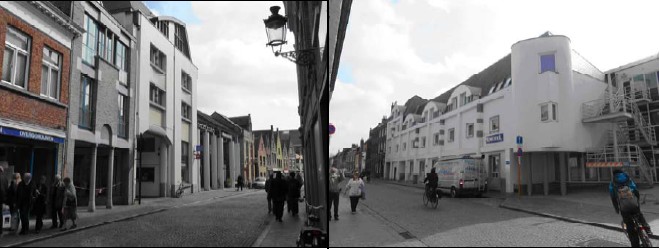
The Novotel hotel (Source: J. Sorosh-Wali)
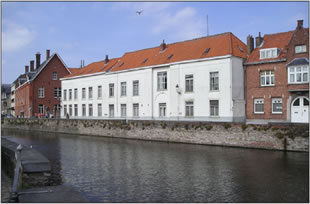
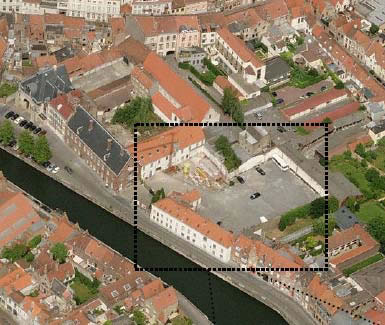
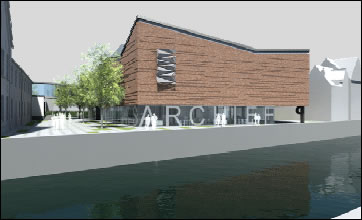
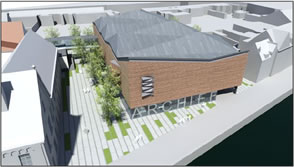
Project “Recordsoffice” (Source: City)
3.3.4 Transformation of public, social and religious buildings into dwellings – In the case of some important complexes of buildings their original function is not needed and redevelopment for new use is proposed. Designed solutions represent considerable impact on the integrity of the site concerned. Often additional buildings, mainly from the 19th and 20th century are undervalued in their urban context and considered for demolition or heavy transformation. The project proposals for the former convent in the Katalijnenstraat and for the “Old People’s Home – Potterie” (see below) exemplify this.
pagina 17
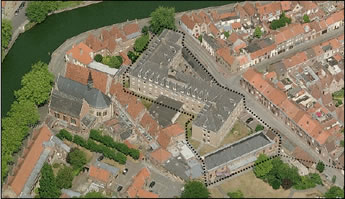
The current buildings erected in 1972, will be demolished. On this site a new old people’s home will be built. (Source: City)
3.3.5 Concentration of commercial and administrative capacity in proximity to the World Heritage property. On the limit of the buffer zone in the Railway station area new development is planned with large scale functions. The spatial plan considers the area as a prime location for city development.
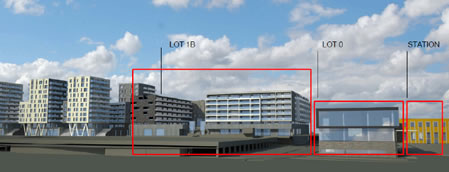
Development Railway Station and Surroundings – project “Balcony on Bruges” (Source: City)
pagina 18

Ongoing Development Railway Station and Surroundings – project “Balcony on Bruges” (Source: J.Sorosh-Wali)
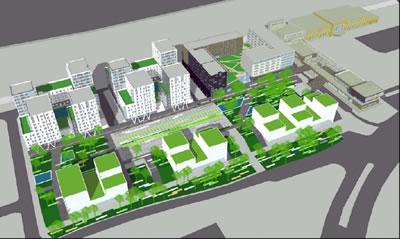
Further developments “Balcony on Bruges” (Source: City)
As a consequence the impoverishment of urban space in the historic area can be expected in relation to the ongoing or possible new use and functions for existing buildings such as the Weyler-Barracks, Military hospital, Langerei Landuse Department, Convent Katelijnestraat.
pagina 19
3.3.6 Lack of visual impact assessment studies for new developments
Insertion of new volumes in the existing urban fabric of the World Heritage property and its close vicinity can result in conflicting, unexpected non-intentional change of the characteristic views (see example of Apartments in Gulden Vlieslaan below). The visual integrity and quality of the World Heritage property relates to the Outstanding Universal Value of the ensemble. That is why the projects for new insertions in the urban fabric must be considered in a broad context not limited to the 50m protective area, including the Railway station project, Record Office, Old People’s Home, and any other project affecting the Outstanding Universal Value and the visual integrity of the property.
Apartment project realisation “Gulden Vlieslaan” (Source: City)
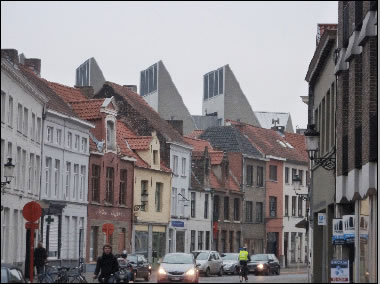
Views on the Apartments “Gulden Vlieslaan” where the City authorities acknowledge to having neglected the visual impact from the World Heritage property (Source: City)
pagina 20
4. ASSESSMENT OF THE STATE OF CONSERVATION OF THE SITE
The property of Brugge was inscribed under criteria ii, iv and vi. The Outstanding Universal Value of the property is represented by the complexity of urban, architectural, artistic, social and environmental qualities. Comparison of the state of conservation of the property before inscription with the actual current state indicates considerable positive results regarding individual restoration works. The public space is well maintained, and urban infrastructure is improved. The revitalisation of artistic activities also contributes to the overall quality of the property. Unfortunately, there are signs of degradation due to inconsistent preservation of minor architecture, and transformation of public and religious ensembles within the urban fabric by introducing new functions often incompatible with their historic built substance. An external threat for the visual quality of the property is the development of very high industrial installations in the proximity of the buffer zone and in the port area further away.
5. CONCLUSIONS AND RECOMMENDATIONS
Legal protection
The listed buildings, city sights and sites within the city centre do not cover the entire surface of the property. In the existing system, the complementary measures, as shown by emerging controversial projects, are not efficient enough to protect the property’s integrity and authenticity in the long term.
Nowadays a number of valuable properties are not listed or only one part of the buildings forming an ensemble are protected by listing which would allow possible demolition or heavy transformation. The 50m protective zone around listed buildings is not effective enough to prevent the unsuitable impact of new building activities on the integrity of the surroundings of listed buildings. In the case of the World Heritage property Historic Centre of Brugge the aspect of the ensemble is core to the statement of outstanding universal value.
The option formulated by heritage preservation associations to classify the property within the national legislation as an urban landscape should be considered.
Spatial planning
The preservation of outstanding universal values of the World Heritage property depends strongly on balance between development of the whole area of city of Brugge and specific urban functions compatible with the quality of the historic centre. Extensive use of certain areas within the historic centre is not the only threat. The fact that ensembles of public social and religious buildings are gradually losing their original function is alarming. The planned development in the very proximity of the World Heritage property accelerates this process.
Existing planning tools should foster the conceptual link between City of Brugge development plans and preservation and redevelopment of the World Heritage property Historic Centre of Brugge.
pagina 21
Visual impact assessment
The integrity of the World Heritage properties comprising Historic Centre of Brugge, Flemish Béguinage and Flemish belfry depends on respect for the special visual quality of the ensemble and its setting in the countryside. The existing height limit (40m) for new construction in the area does not by itself protect against non-suitable change in the visual quality.
Visual impact assessment studies should be elaborated by independent bodies at an early stage of planned new intervention in the area.
This will allow corrective measures to be taken during the planning process to avoid adverse impact on the outstanding universal value of the property.
Terms of reference for development of selected areas
In relation to discrepancies occurring between cultural values and change of use at a particular site, preliminary studies should analyse the specific values of the area.
Such a study has to formulate basic requirements concerning preservation of the declared values and define binding conditions for future development.
This will avoid unrealistic expectations of developers in their feasibility studies for planned investment.
In order to help the authorities in the implementation of the above recommendations, the mission further suggests elaborating a retrospective Statement of Outstanding Universal Value, for adoption by the World Heritage Committee.
Without an understanding of what values need to be protected and their implications in terms of spatial patterns and visual integrity, the parameters for protecting key views and regulating heights/silhouettes can not be readily set and agreed.
The main recommendations of the Mission are provided in the EXECUTIVE SUMMARY at the beginning of this report.
pagina 22
6 ANNEXES
ANNEX I - Termes de référence
de la mission conjointe UNESCO/Centre du patrimoine mondial -ICOMOS au site du patrimoine mondial “Le centre historique de Bruges ”, Belgique
(23 – 25 mars 2010)
Dans le cadre de la Décision 33 COM 7B.94 du Comité du patrimoine mondial prise lors de sa 33e session (Séville, 2009), et à la lumières des études et informations qui seront transmises par les autorités belges, la mission doit:
1. évaluer l'impact potentiel du projet du Musée d'histoire, et des interventions au Casselberg, aux Sept Tours et au Bouclier Français sur la valeur universelle exceptionnelle du bien (à l’appui des études d’évaluation d’impact environnemental et culturel succinctes sur ces projets ainsi que sur les autres solutions alternative possibles, qui seront fournies par les autorités) ;
2. examiner l’impact de tout autre projet à l’intérieure ou à l’extérieur du périmètre du bien du Patrimoine mondial pouvant affecter sa valeur universelle exceptionnelle, son authenticité et/ou intégrité, à l’appui des études succinctes fournies par les autorités ;
3. préparer un rapport portant sur ces points, y compris des recommandations, pour examen par le Comité du patrimoine mondial (lors de sa 34e session, 2010).
pagina 23
ANNEX II - Itinerary and Programme
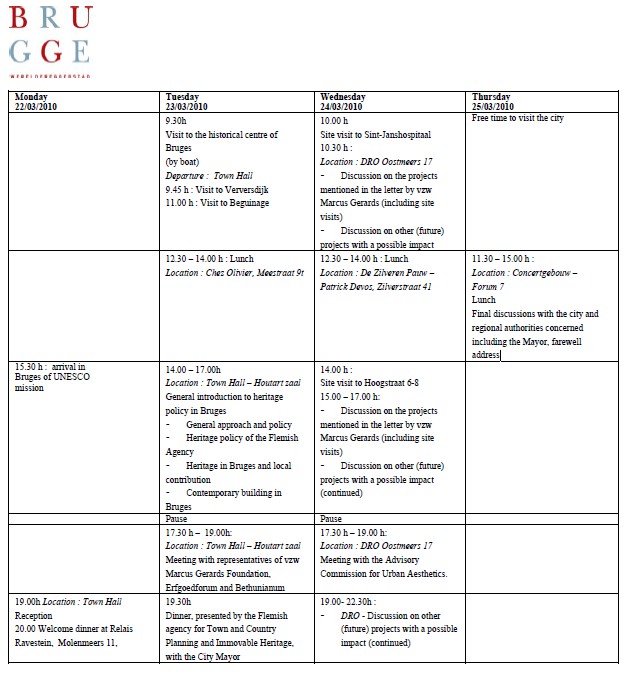
pagina 24
ANNEX III - Composition of Mission Team
1. Mr Jaroslav KILIAN
ICOMOS Expert
49-51, rue de la Fédération
75015 PARIS
E-mail : kilian@ainova.sk
2. Mr Ahmad Junaid SOROSH-WALI
Programme Specialist
Focal Point for Western, Baltic, Nordic and South-East Mediterranean Europe
Europe and North America Section
UNESCO World Heritage Centre
7, Place de Fontenoy, 75352 Paris 07 SP - France
Tel: +33 (0)1 45 68 07 38
Fax: +33 (0)1 45 68 55 70
E-mail: j.sorosh@unesco.org
http://whc.unesco.org
3. Ms Regina DURIGHELLO
Director of World heritage Programme
Conseil International des Monuments et des Sites (ICOMOS)
49-51, rue de la Fédération
75015 PARIS
Tel: +33 (01) 45 67 67 70
E-mail : regina.durighello@icomos.org
pagina 25
ANNEX IV – List of Persons met during Mission
23 MARCH 2010 –
MEETING WITH REPRESENTATIVES OF VZW, MARCUS GERARDS FOUNDATION, ERFGOEDFORUM AND BETHUNIANUM
A. Junaid Sorosh-Wali
UNESCO/WHC
j.sorosh@unesco.org
Regina Durighello
ICOMOS International Secretariat
+33 (0)145 67 67 70
Mr Kilian
ICOMOS expert
Wouter Priem
Voorzitter Erfgoed Forum, Brugge VZW
w.priem@telenet.be
Jan Dumolyn
University of Gent, Belgium
Jan.dumolyn@ugent.be/
+32 933 10 217
Luc Devliegher
Member of the Flemish Academy of Belgium
+32 (0)50 38 40 29
Andries van den Abeele
President of the Association Marcus Gerards
abeele@skynet.be/
+32(0)50 33 81 43
Jean van Cleven
Bethunianum VZW-Centre pour l’étude de l’art belge du 19 siècle
jfvancleven@hotmail.com /
+32 (0)9 374 29 79
Paul Dequae
Vice-President Erfgoedforum VZW
Paul.dequae@myonline.be
Annita Stevens
Alg Directeur Ruimte&Erfgoed
Annita.stevensen@rwo.vlaanderen.be
Gilbert Kolacyn
General Administrator Ruimte&Erfgoed
Gilbert.kolacny@rwo.vlaanderen.be
Piet Geleyns
UNESCO Focal Point / Ruimte & Erfgoed
Piet.geleyns@rwo.vlaanderen.be
Luc Constandt
Stad Brugge
+32 (0) 50 44 85 88
Miek Goossens
Heritage Board Flemish Region
+32 (0)50 44 29 56
24 March 2010 –
MEETING WITH SERVICE MUNICIPAL D’AMENAGEMENT DU TERRITOIRE ET DU PATRIMOINE
Piet Geleyns
WH Focal Point / Ruimte & Erfgoed
Piet.geleyns@rwo.vlaanderen.be
Dirk van Eenhooge
Onroerend Erfgoed w. Vlaanderen
Dirk.vaneenhooge@rwo.vlaandren.be
Joris Nauwelaerts
Architect Dienst Monumentenzorg Stad Brugge
joris.nauwelaerts@brugge.be
Brigitte Beernaert
Architect Historica Dienst
Brigitte.beernaert@brugge.be
Monumentenzorg Stad Brugge
pagina 26
Luc Constandt
Director Stad Brugge
Luc.constandt@brugge.be
Regine Durighello
ICOMOS International Secretariat
+33 (0) 1 4567 67 770
Jaroslav Kilian
ICOMOS Expert
+42 1 90 37 60 153
Junaid Sorosh-Wali
UNESCO/WHC
j.sorosh@unesco.org
Dries Willems
Déléguée adjoint du gouvernement Flamand, Ambassade de Belgique, Paris
drieswillems@delegationflamande.org
Jan de Bischop
Secretaire Generale/ Commission Flamande pour l’UNESCO
Jan.debisschop@iv.vlaanderen.be
Ingrid Leye
ARCH – Acting Chief of Dep. for Monuments Protection and Urban Renewal
Ingrid.leye@brugge.be
24 MARCH -
MEETING WITH THE ADVISORY COMMISSION FOR URBAN AESTHETICS
Marc de Brabandere
Fonctionnaire, Géomètre – Expert
Marc.debrabandere@hotmail.com
Katrien Morro
Licentrice d’histoire de l’art (25 ans dans la Commission)
Katrien.norro@pandora.be
Hilde de Bruyne
Archiviste et responsable du patrimoine d’art du CPAS – Bruges
Archief-kunst@ochw-brugge.be
Bob Vanhaverbeke
Pharmacien, Président de l’association « Brugge du Scone »
Bob.vanheverbeke@telenet.be
Piet Swimberghe
Historien d’art, journaliste
Piet.swimberghe@telenet.be
Sebastien Vermusch
Architecte indépendant
info@architectenvermursch.be
Olivier Salens
Architecte
Olivier@salensarchitecten.be
Guy Delbecque
Agent immobilier
guy@guydelbecque.be
Lori van Biervliet
Historienne 18eme siècle, le néogothique plus soins des monuments et sites
Fernand.traen@skynet.be
Cloet Hilok
Maatschappelijk assistente stadtgids
Hilok-cloet@skynet.be
Regine Durighello
ICOMOS International Secretariat
+33 (0) 1 4567 67 770
Jaroslav Kilian
ICOMOS Expert
+42 1 90 37 60 153
Junaid Sorosh-Wali
UNESCO/WHC
j.sorosh@unesco.org
pagina 27
24 March 2010 –
MEETING WITH SERVICE MUNICIPAL D’AMENAGEMENT DU TERRITOIRE ET D U PATRIMOINE, suite
Piet Geleyns
WH Focal Point / Ruimte & Erfgoed
Piet.geleyns@rwo.vlaanderen.be
Miek Goossens
Ingrid Leye
ARCH – Acting Chief of Dep. for Monuments Protection and Urban Renewal
Ingrid.leye@brugge.be
Brigitte Bernaert
Architect Historica Dienst Monumentenzorg Stad Brugge
Dirk van Eenhooghe
Luc Constandt
Director Stad Brugge
Merceder Vanvolcem
Deputy Mayor
Regine Durighello
ICOMOS International Secretariat
+33 (0) 1 4567 67 770
Jaroslav Kilian
ICOMOS Expert
+42 1 90 37 60 153
Junaid Sorosh-Wali
UNESCO/WHC
j.sorosh@unesco.org
pagina 28
ANNEX V – Maps
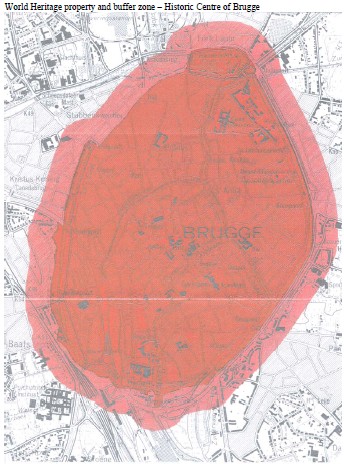
World Heritage property and buffer zone – Historic Centre of Brugge
pagina 29
ANNEX VI – Photographs and illustrations
Interventions in the Hoogstraat “Casselberg, Sept Tours and Bouclier Français”
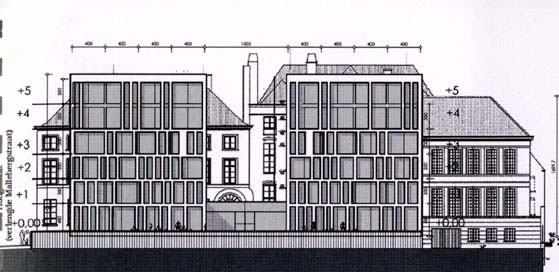
Hoogstraat Hotel proposal project of 2003 adopting the volume of the existing buildings (Source: City)
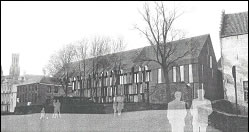
The new building proposal of 2003 was almost completely independent of the surrounding historic buildings enabling the restoration of the rear façade (Source: City)
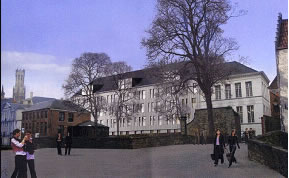
The façade design is subject to repeated discussions with the Commission for Urban Aesthetics between 2003 and 2008 (Source: City) 29
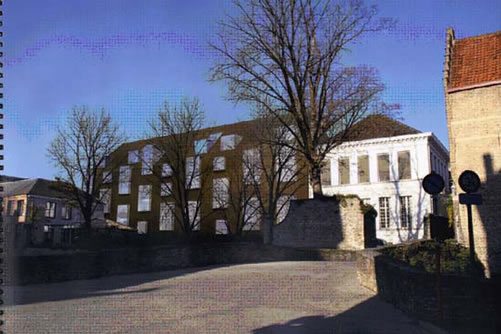
Final proposal for the Hotel façade approved by the Commission in September 2008 (Source: City) 30
